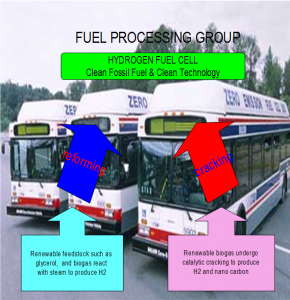Fuel Processing
INTRODUCTION
The Fuel Processing Research Group are focusing on production of hydrogen from renewable and sustainable feedstock for fuel cell application. Current research topics include catalytic cracking of biogas, catalytic reforming of renewable material such as bioethanol and glycerol for production of hydrogen, and hydrogen storage in carbon and metal nano fiber. Major barrier in commercialization of hydrogen from biomass and biowaste is the low efficiency and low rate of H2 production. The use of new materials such as new nanostructures, nanomaterials and nanosystems have great potentials in improving H2 production and fuel cell technologies. In addition, the group also focusing ong synthesised of novel material for hydrogen storage.
Hydrogen is considered to have a bright future as a source of clean energy, mainly through its use as fuel in fuel-cell systems, which are described as continuously operating batteries; one of the cleanest and greenest sources of electrical energy. Unfortunately, hydrogen does not exist in nature in its elemental form and, therefore, it has to be produced from hydrocarbons, water, or any other hydrogen-containing compounds, such as alcohol. Currently, there are four basic methods in common use for hydrogen production i.e., water electrolysis, gasification, partial oxidation reactions of heavy oil, and steam-reforming reactions. In general, the main source of hydrogen will vary with the geographical location of its demand. For instance, in countries with ample electricity resources, the water electrolysis method to produce hydrogen would be preferred. For Malaysia and the surrounding countries, glycerol, by products of biodiesel plant, biogas, available in many agriculture effluent or bioethanol produced by the fermentation of renewable materials would be an ideal choice as a hydrogen carrier because of the productive agriculture and extensive plantations such as oil palms.
On the other hand, the key challenge in developing this hydrogen technology is hydrogen storage. One of the greatest challenges is to find a safe, reliable and efficient method for hydrogen storage. Current methods for hydrogen storage have yet to meet all the demands for onboard applications. High-pressure gas storage or liquefaction cannot fulfill the storage criteria required for on-board storage. Solid-state materials have shown potential advantages for hydrogen storage in comparison to high-pressure gas storage or liquefaction. Most of the chemisorption-based materials are very expensive and in some cases, the hydrogen absorption/desorption phenomena is irreversible. Furthermore, a very high temperature is required to release the adsorbed hydrogen. On the other hand, the main drawback in the case of physisorption-based materials and methods is their lower capacity for hydrogen storage, especially under mild operating conditions. Many alloys have the ability to adsorb and desorb large amounts of hydrogen at special pressures and temperatures to form metal hydrides. In our research group, we invistigate the use of carbon nano fiber and metal nano fiber for hydrogen storage. Carbon and metal nanofiber were synthesised by a sol-gel process via electrospinning. High surface area of the synthesised material demonstrate the capability of nanofibers to serve as effective material in hydrogen storage application.
RESEARCH TEAM
- Prof Ir Dr Zahira Yaakob, PhD (UMIST) – Group Leader
- Prof Dato’ Ir Dr Wan Ramli Wan Daud, PhD (Cambridge)
- Prof Dr Siti Kartom Kamarudin, PhD (UKM)
- Assoc Prof Dr. Siti Masrinda Tasirin, PhD (Bradford)
- Assoc Prof Dr Edy Herianto Majlan, PhD (UKM)
- Dr Manal Ismail, PhD (Imperial College)
- Dr Teuku Husaini, PhD (UKM)
- Mr Lim Kean Long, Meng (UKM)
- Dr Raj Kumar, PhD(postdoc)

